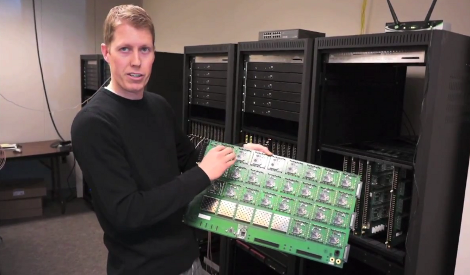
So let’s say that you’re a developer on the Xbee team. You need to test the extremes of what the RF radio modules can do when in a large network. But in addition to numerous nodes, you also need to test the effects of distance on the radios. Since it’s not reasonable to distribute hundreds of the devices (each with their own power source) throughout town, you build a test setup like the 1 kilonode Xbee rig which the project manager, [Jared Hofhiens] is showing off.
He’s holding one blade from the rack-mounted system. Each of those squares is an Xbee module, there’s 32 etched onto the board. On the edge furthest from him there are a set of connectors which mate with the rack connectors, hooking the blade up to a set of terminal servers. These servers allow developers to ssh into individual modules. On the near side of the blade there’s a set of attenuation adjustment circuits. They allow adjustments of 0-40 dB of attenuation in 10 dB increments to adjust how strong the RF signals are, simulating distance between modules.
Thirty-two of these cards are mounted in the three racks seen above to make up the 1024 module node. We really appreciate this look behind the scenes and think you’ll enjoy the video tour after the break. If it leaves you wanting more check out how one company builds cloud storage.
http://www.youtube.com/watch?v=QeSvAn-YRSE
[Thanks Chris]















That is is cool
Wow. That is cool. I hope HaD finds more things like this.
I love seeing what goes on in the professional labs.
Attenuation seems like a pretty half-assed way of simulating distance. Kind of missing the latency, guys. And interference, reflection, absorption, etc.
Attenuation is a good first step for a lab such as this. But you’re right — there are lots of other factors to be considered, BUT they can also be simulated with a variety of injectors, filters, latency simulators, delayers, etc.
I used to work in a cell-phone equipment testing lab, and we went to great pains to simulate every condition conceivable before taking the units out into the field for more testing. Of course, my favorite testing involved taking a shotgun against the radiators (repeatedly, until failure :) )
any videos or photos of this lab you could share?
@griffon — regrettably, no. It was shut down last year, and almost all the equipment sold for scrap.
Anyway, as labs go it wasn’t the cleanest or particularly well designed. Not everybody who worked there was dedicated to keeping things clean and neat — just do your job and leave things for the next person to fix was the typical way of doing things. People just got used to things being like that before my team took over and started “cracking the whip.”
Saddest part: We had just completed a major HVAC and patch-panel automation upgrade when we were ordered closed by HQ. Given enough time, we would have eventually weeded out the bad apples and turned the place into a showpiece, but it just wasn’t meant to be.
@griffon — found some pics from the same company.
This — http://www.flickr.com/photos/fenng/3352571689/ — is slightly worse that what I started with…
This — http://www.rcrwireless.com/siliconvalley/20110511/networks/a-glimpse-inside-the-ericsson-innovation-labs-in-san-jose/ — is what we were attempting to model ourselves after. Not perfect, admittedly, but reasonably clean, labeled, and usable.
This — http://www.bgr.com/2011/07/20/photo-tour-this-is-the-future-of-sprints-network/ — is approximately where we were when we shut down.
Something that wasn’t mentioned in the video is that potential customers can rent time with the Digi kilonode to simulate their own configuration in a large-scale wireless network.
Cool beans… I can see why they used their own 32-port serial servers. Those things retail for $2000 a pop, and they have 32 of them! I still don’t understand why they’re so expensive. Average seems to be $60-$80 per port. Maybe just a demand thing since most of them seem to wind up in industrial automation applications.
Digi CM32’s can be had used for around $100 each, if you look hard enough.
This looks quite similar to what the guys at INRIA are doing: senslab.info